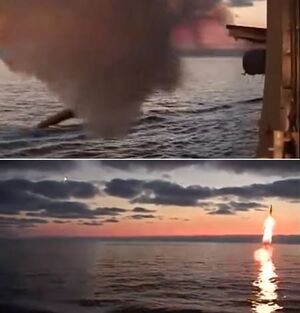HŎ-2 Poksŏl
The HŎ-2 Poksŏl is a type of anti-submarine missile developed in Menghe during the early 1990s. It is designed to be launched from a 533mm torpedo tube, either on a submarine or a surface warship. HŎ-2 stands for Hwajŏn Ŏroe, or "rocket torpedo," and Poksŏl means "heavy snow." Menghean rocket artillery systems have historically been named after weather systems.
History
During the 1970s and 1980s, the Democratic People's Republic of Menghe made several efforts to develop an anti-submarine guided torpedo which could be deployed by missile, as a way of extending warships' attack reach. The HŎ-1, approved for service in 1979, was a rocket-propelled drone carrying a 450mm guided torpedo, but due to its large size, it had to be launched from a traversing deck rail and reloaded with a crane. Because the rocket was liquid-fuelled, it also had to be stored with the fuel tanks empty, resulting in a long response time from a low-readiness state. In the end, the HŎ-1 was not mounted on any Menghean warships.
Development work on a more compact standoff torpedo delivery system began in the early 1980s, but languished during the poltical instability and economic isolation of that period. After the Decembrist Revolution, work on the system resumed, this time with an expanded design team and better access to foreign technology. The selected torpedo was also lighter, at 350mm in diameter, and carried a superior seeker head. Tests of the weapon proceeded during the early 1990s, and in 1993 it was reportedly test-fired from the Large ASW Ship Chamjok Jachido.
During the mid-to-late 1990s, the HŎ-2 was integrated onto many Menghean surface warships and submarines. Because it was compatible with existing 533mm torpedo tubes, the HŎ-2 required only minimal modification of the base vessel, especially if the base vessel was already outfitted to fire guided anti-submarine torpedoes.
Operation
The HŎ-2 Poksŏl is relatively unique among standoff torpedo systems in that it is designed to be fired from torpedo tubes, including the torpedo tubes of a surface warship. Letnia is one of the few countries to use a similar system, on its RPK-7 Vodopad and RPK-7 Veter.
On a surface vessel, the HŎ-2 is first blown from the ship's 533mm torpedo tubes like a standard torpedo, dropping into the water. Once in the water, the missile fires its first-stage rocket booster, rights itself, and climbs, breaking through the surface and flying toward the target. Submarine-based launches are similar. This launch sequence minimizes the need for specialized launch equipment, but it has the disadvantage of creating a loud underwater noise, alerting the target submarine that it is under attack and revealing the attacker's location.
Once airborne, the missile follows a ballistic trajectory toward the launch destination. It remains on course with the help of an inertial navigation system, which also helps it right itself and direct itself toward the target while underwater. The missile reportedly does not have any provisions for mid-course correction. As it enters the final phase of its dive, the missile's fuselage breaks away and its payload - a 350mm YŎ-35/1 torpedo - descends to the surface with the help of a drogue chute. In the water, the torpedo breaks free of the chute and begins a circling descent with its active sonar running. Once it locks onto a submerged target, it accelerates and autonomously homes in.
Poksŏl-N
The HŎ-2N variant, unveiled in 2004, uses the same base rocket but carries an improved YŎ-35/2 torpedo. The new torpedo has a longer loitering time, a greater service depth, and improved sonar sensitivity, for an increased kill probability. It also has a new parachute system, with a much lower splashdown speed, and it can be programmed to search for the target using passive sonar. These changes somewhat reduce the submarine's ability to detect the incoming torpedo, but because of the missile's underwater launch, firing the weapon still alerts the submarine that the missile is incoming.
Launch platforms
- Chanjok Jachido-class cruiser
- Yobu-class destroyer
- Hyŏngnam-class destroyer
- Pyŏng'an-class destroyer
- Ginam-class frigate
- Ansa-class frigate
- Hawŏn-class frigate
- Mugunghwa-class corvette (certain refitted hulls)
